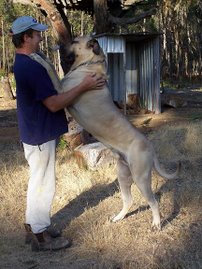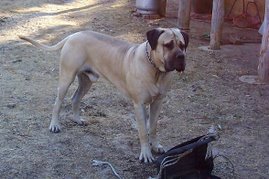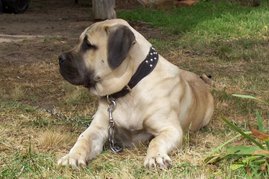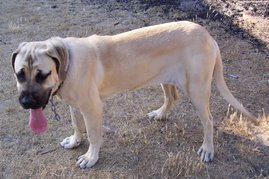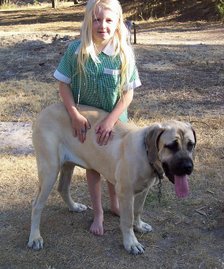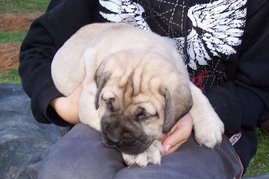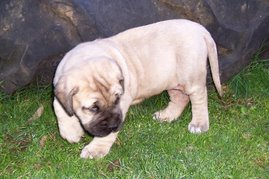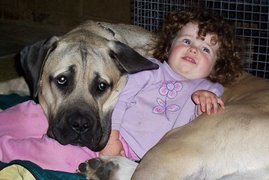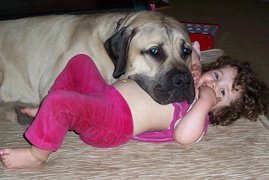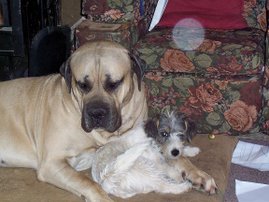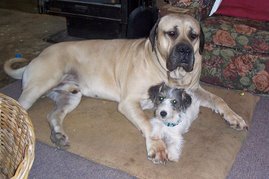Due to many requests we will attempt to cover some of the basics to make the transition to a new home easier for both owner and puppy!
BEFORE YOU LEAVE TO PICK UP YOUR PUPPY:
- Section off a small area for your dog and "toddler proof" your home and/or outdoor area eg. dangling electrical cords, slippery surfaces, gaps in fencing, small items for choking risk etc all need to be taken care of. A puppy is just like a small child
- make sure you have called a few vets in your area and determined if there are any who specialise in large breed dogs.
- your breeder should have given you a diet and care sheet before you pick up your puppy, this will enable you to have all the correct food and any medication (worming treatments and the like) ready.
- when travelling always have a suitable crate so your puppy can be safely contained, holding them on your lap is not safe!
- ideally the breeder will not have fed the pup since the night before you are due, this will minimise the chances of the dog being ill or making a mess. Always stop every hour or so to let your pup out. Bring an empty bottle with you so you can fill it up at the breeder's house for the trip home. You can buy collapsible water containers for use when travelling - a plastic shower cap will also do the job.
- bring a towel or similar cloth with you and get the breeder to rub it all over the mother before you leave. Spread it over the pup's new bed when you get home and he/she will accept it.
- bring newspaper with you and either ask breeder to give you a piece the pup has already toileted on or keep a piece from the journey home. Place this in the area where you would like your pup to toilet.
WHEN YOU GET HOME:
- keep puppy contained in a small area, giving him/her the run of the house will not only make toilet training difficult but it will overwhelm the pup.
- don't feed pup for at least 3 hours after travelling, leave only fresh water.
- make sure pup's bed is not too big, they like a small cosy nest to sleep in. When sleeping with their litter mates they are all squashed up into a tight ball so like the safety of confinement. Most pups cry at night due cold, a small cosy bed will help prevent this.
- if bringing home a pup with children in the house make sure the children understand that when pup is in it's bed it isn't to be touched, puppies need an enormous amount of sleep or they will fail to thrive and become bad-tempered. A large cage is ideal for this purpose, when pup is in the cage it shouln't be touched, when it chooses to come out then playtime can commence.
TOILET TRAINING:
- if keeping dog indoors hopefully you have a huge stockpile of newspapers collected before you bring your pup home. As suggested above, put a piece of used paper on top of the fresh paper to help pup know the appropriate place to toilet. It is always wise to place this paper near a door, it makes the transition to outdoors easier.
- if dog is kept outdoors, take pup to the place you would like him/her to use. Always leave one poo in the place you want pup to use, if you remove all the poo everyday then pup will have trouble knowing the correct area.
- the best times to take pup out to toilet are when he/she wakes, after exercise or playing, half-way through mealtime and about half an hour after mealtime. If you take pup out half-way through a meal you will find pup eats better.
A Brief History:
Mastiff dogs are one of the oldest recognised breeds in the world and have been depicted on rock carvings, statues and artwork throughout history as far back as 2,000 years before Christ. The modern breed was developed in England in the early 20th Century before almost dying out in the 2nd World War. A joint effort between England and USA successfully restored the numbers and now although not a common breed, the are no longer rare. There are also Tibetan, Neapolitan, French and Argentinean Mastiffs although these are all different from the English.
Physical Characteristics:
English Mastiffs are large, heavy, muscular dogs and are in the ‘giant’ breed category. The largest dog in the Guinness Book of Records is an English Mastiff who tops the scales at 155 kilograms!
Height to shoulder is approximately 70-76 cms (20.5-30 inches)
Weight is 79-86 kilograms.
Coat colours – most common colour is fawn with a black mask (see pictures). There are other variations like silver-fawn, apricot-fawn and brindle (brindle and its variations are uncommon and hard to find).
Pros & Cons of owning a Mastiff:
Pros:
Easy coat care, highly intelligent, excellent guardian, gentle, rarely bark, affectionate and loyal.
Cons:
Can be stubborn, aren’t often willing to perform ‘menial’ tasks/tricks, drooling and slobbering at mealtimes or after drinking, tail is like a whip so you can’t have ornaments. You need a vehicle that can transport them (or a trailer) – they don’t fit in your average family sedan. Some of the more heavily wrinkled adults have furrows that need to be cleaned on a regular basis. It is also wise to have air-conditioning in your house and car as they don't tolerate the heat.
The following can be pros or cons, depending on your viewpoint:
Often described by owners as “annoyingly affectionate” – they love to follow their owner everywhere and if they could they would get into your lap for a cuddle! Have a habit of leaning against you and lying with their head on your feet (remember what they weigh!).
If going out in public with your Mastiff be prepared to be stared at and questioned incessantly - people are fascinated as they are rarely seen.
What to look for:
Look at as many dogs (pictures or real) as you can so you are familiar with the breed and decide how you would like your dog to look. There are heavily wrinkled Mastiffs and ones who are tighter skinned. Bone lazy ones and those who are more active. Taller thinner ones, or shorter stockier ones. Then put most of your time into inspecting the parents as they are the best indicator of what your puppy will be like.
Please don't judge the female too harshly if you are seeing her for the first time with her puppies - pregnancy and lactation take their toll on a bitch's physical appearance so rely on photos of her prior to giving birth!
If you want a working Mastiff – one who does the job of guarding and isn’t just a wrinkly face! – then make sure the parents show signs of this when you visit. Parents who bound up to you and lick you to death will have puppies who are similarly jolly. Ideally the Mastiff will watch you intently on arrival and bark – then when told by the owner it is ok they should settle down and even allow you to pat them. They will always watch you intently though.
Availability:
English Mastiffs are an uncommon breed so are not readily available. Most breeders have at least a 6 month waiting list. This will give you plenty of time to stockpile newspapers (invaluable item when toilet training puppies!) and make the necessary sundry purchases (dog crates/cages for travelling, bedding, worming treatments etc).
Cost:
Most puppies cost a minimum of $800 and can fetch up to $1500 or more. English Mastiff puppies are expensive in comparison to other breeds because it is expensive to breed a female (who will often eat up to 3 times her normal food intake while pregnant and lactating) and to raise the puppies (food, worming treatments, vet checks etc).
Don’t make the mistake of thinking you can get your money back by breeding from your male/female – giant breed dogs are notoriously difficult to breed and often have trouble during the whelping process (birthing of puppies) – Caesarian births are not unknown.
If you factor in the food and veterinary care for your breeding adults and weigh this up against the fact that most giant breeds can only safely have around 3-4 litters before they are too old, then you will quickly realise that many breeders are running at a loss, most breed for love and not profit.
Purebreed? Pedigree? Registered? Papers? Guarantee?
Most people are confused by these terms and what they mean to you as a buyer. Simply put a purebreed dog is one who meets the criteria set by the various Kennel Clubs/Canine Associations. This means the puppy/adult must have proven ancestry for a certain number of generations (usually 3) - this is their 'pedigree'. In order for an animal to be shown it must be registered with the Kennel Club and have papers that detail the puppy’s ancestry.
BUT at times these pieces of paper are just that, worthless pieces of paper. They are bought as blanks and the owner fills them in. An unscrupulous owner can put whatever they like. There is no way of guaranteeing what they are filling in is the truth. If you don’t want a dog for showing, papers are not necessary.
Guarantees - a little advice that I have learned the hard way. Just because a puppy has papers in no way guarantees you a healthy animal. Being registered and/or a Champion dog (have a prefix of Ch before their name) in no way means a healthy animal. There are many stories of buyers having puppies with major health problems even though they had a "guarantee". This is one of the many stories about such a dog - a champion registered papered animal who only lived a short life:
http://www.users.bigpond.net.au/mastiff/ABOUTUS.HTM
Read also my post further down on Hip/Joint problems for the reasons why these "health guarantees" are useless. No-one can guarantee the health of your puppy - but you can help prevent potential problems with a little knowledge.
Blog Archive
Friday, January 5, 2007
Subscribe to:
Posts (Atom)
